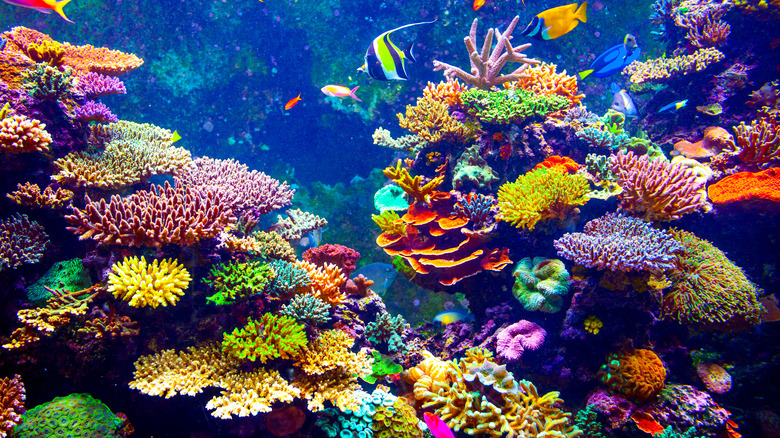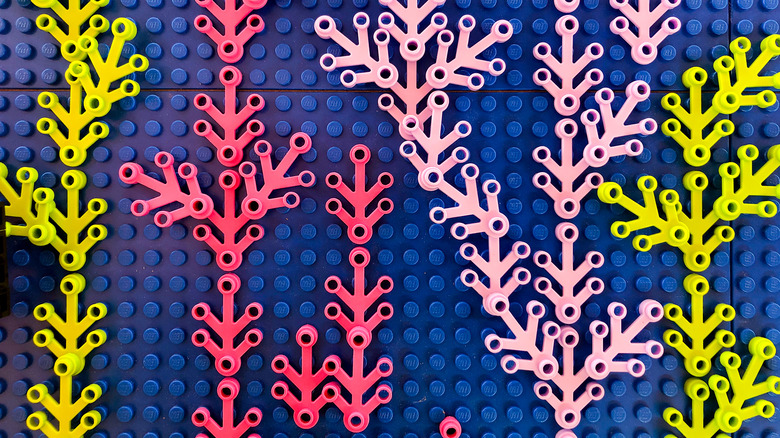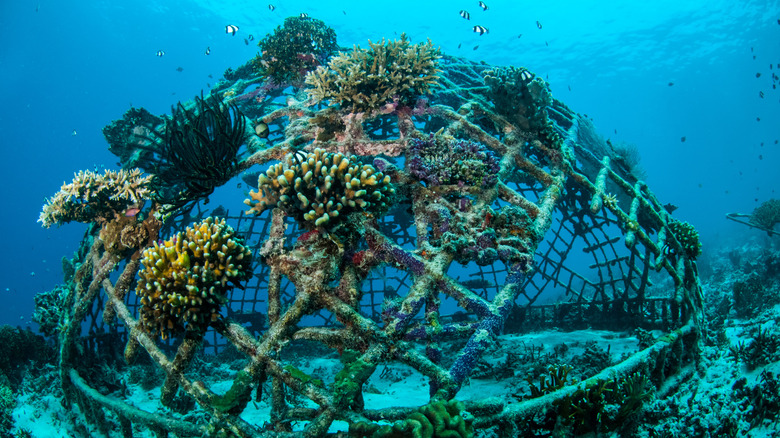Singapore Is Using Legos To Rebuild Their Coral Reefs. Here's How
The waters off the tiny island city-state of Singapore are home to a stunning one-third of the world's coral reef species, outstripped in biodiversity only by Australia and the Maldives. This is quite a point of pride for a nation 562 times smaller than California (measured by My Life Elsewhere) yet is home to a whopping 5.4 million packed-in people, per Reuters.
It's also a reason to step up, take responsibility, and try to stem the tide of climate change that's already annihilated much of one of Earth's most precious marine animals — coral. As Vice reported, between 2016 and 2017 alone, more than half of the entire Great Barrier Reef died due to heatwaves exacerbated by climate change. When temperatures get too hot, coral get stressed out and release their primary food, algae, back into the water causing them to bleach, turn a ghostly white, and die.
So how is Singapore fighting back? In the most unlikely, unpredictable way possible: Legos. Yes, those same toys that kids (and sometimes adults) use to flex their design creativity and spatial reasoning muscles. As the BBC explains, researchers are employing lessons learned from Singapore's cramped urban landscape, blending vertical engineering and vertical farming.
Marine biologists Neo Mei Lin and Jani Tanzil from the National University of Singapore find nearly dead coral and attach small pieces to Lego bricks tied to fishing lines. They lower the lines into an aquarium where they examine how the coral affix themselves and grow.
Rescuing the 'uncharismatic' animals of the sea
So why Legos? Peculiar as it might seem, the reasoning is sound. As researcher Jani Tanzil told the BBC, Legos are modular and scalable — they're easily moved and recombined into different shapes and sizes.
As Vice reported, the team is working on St. John's Island off the southern tip of Singapore, in conjunction with government agencies like the National Parks Board. The project has garnered attention amid a growing environmental awareness amongst Singaporeans. During the COVID-19 pandemic, borders were closed and boating routes were shut down. The region's tropical environment subsequently thrived. Species such as whale sharks and eagle rays, for instance, returned to the country's waters.
Coral is gorgeous when thriving and vibrant, but animals like sharks get more attention from the public. Sea urchins, mollusks, sea cucumbers, etc., are often overlooked for being "uncharismatic," as Tanzil and Neo say. "Singapore has many green plans and goals but marine issues are often out of sight," Tanzil told Vice. "We want to embark on our own 'blue plan' for our oceans and seas and teach Singaporeans new values like retention, rejuvenation, and restoration so that we can appreciate what we already have before it's too late."
Other countries have gotten on board
Readers might recognize an obvious issue with using Legos: they're made from plastic, and plastic is super harmful to the environment. Of course, researchers are aware of this. The current experiments are being conducted under controlled circumstances, not willy-nilly in the open ocean. The hope is to gather data, learn about best practices, and then expand on the initiative and help rebuild, reconstruct, and preserve the area's coral reefs. It's somewhat poetically ironic that a destructive substance can be wielded to promote life.
Singaporean scientists aren't the only ones making such efforts, though. Hong Kong researchers are employing a similar strategy, except they're using 3D-printed coral reef beds to encourage growth, as Phys explains. The material in this case? Clay tiles, which are "basically soil," per Phys, and perfectly fine for the environment.
The BBC reports in Indonesia, local groups have worked with NGOs, The Nature Conservancy, and Sheba, the pet food company, to repopulate coral reefs using steel-framed "reef stars" on which coral can grow. Currently, they've repopulated the sea bed from 5% cover to 55%.
Researchers in the Bahamas, on the other hand, are working to breed hardier coral that can survive extreme weather conditions. Per Vice, they're helping nature pre-select for its strongest by breeding coral in tanks at a higher heat and acidity; those go back to the ocean. Such effort is not only heartening but necessary if we're going to preserve our Earth and its diversity of life.


